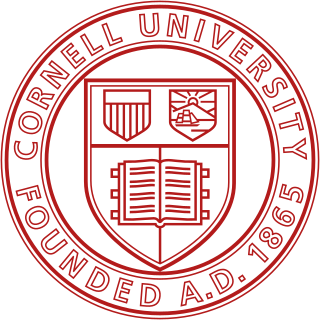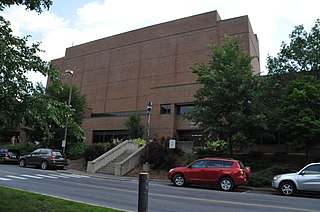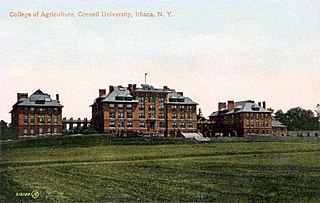
The State University of New York College of Environmental Science and Forestry (ESF) is a specialized, doctoral-degree granting institution in Syracuse, New York. It is part of the State University of New York (SUNY) system. ESF is immediately adjacent to Syracuse University, within which it was founded, and with which it maintains a special relationship. It is classified among "R2: Doctoral Universities – High research activity".

The New York State University College of Human Ecology (HumEc) is a statutory college located on the Cornell University campus in Ithaca, New York. The College of Human Ecology is a compilation of area of study, such as design, design thinking, consumer science, nutrition, health economics, public policy, human development and textiles, each through the perspective of human ecology.

The College of Arts and Sciences is a division of Cornell University. It has been part of the university since its founding, although its name has changed over time. It grants bachelor's degrees, and masters and doctorates through affiliation with the Cornell University Graduate School. Its major academic buildings are located on the Arts Quad and include some of the university's oldest buildings. The college offers courses in many fields of study and is the largest college at Cornell by undergraduate enrollment.
The New York State Agricultural Experiment Station (NYSAES) at Geneva, Ontario County, New York State, is an agricultural experiment station operated by the New York State College of Agriculture and Life Sciences at Cornell University. In August 2018, the station was rebranded as Cornell AgriTech, but its official name remains unchanged.
Cornell University Dairy Cattle Teaching and Research Center or Cornell Dairy is about a 25-minute drive from Cornell University's Ithaca, New York campus and is home to over 900 milk-producing cows. The milk is used to make various signature products, including ice cream, cheese, and yogurt, which are sold on campus. The products are also served in Cornell Dining facilities for students and faculty consumption. The dairy is used as a training facility for students in both the College of Agriculture and Life Sciences and the College of Veterinary Medicine.

The history of Cornell University begins when its two founders, Andrew Dickson White of Syracuse and Ezra Cornell of Ithaca, met in the New York State Senate in January 1864. Together, they established Cornell University in Ithaca, New York, in 1865. The university was initially funded by Ezra Cornell's $400,000 endowment and by New York's 989,920-acre (4,006.1 km2) allotment of the Morrill Land Grant Act of 1862

The Cornell Botanic Gardens is a botanical garden located adjacent to the Cornell University campus in Ithaca, New York. The Botanic Gardens proper consist of 25 acres (10 ha) of botanical gardens and 150 acres (61 ha) of the F. R. Newman Arboretum. The greater Botanic Gardens includes 40 different nature areas around Cornell and Ithaca, covering 4,300 acres (1,700 ha).

Cornell University is a private Ivy League and statutory land-grant research university, based in Ithaca, New York. Founded in 1865 by Ezra Cornell and Andrew Dickson White, Cornell was founded with the intention to teach and make contributions in all fields of knowledge — from the classics to the sciences, and from the theoretical to the applied. These ideals, unconventional for the time, are captured in Cornell's founding principle, a popular 1868 quotation from founder Ezra Cornell: "I would found an institution where any person can find instruction in any study."

The University of Florida Institute of Food and Agricultural Sciences (UF/IFAS) is a teaching, research and Extension scientific organization focused on agriculture and natural resources. It is a partnership of federal, state, and county governments that includes an Extension office in each of Florida's 67 counties, 12 off-campus research and education centers, five demonstration units, the University of Florida College of Agricultural and Life Sciences, three 4-H camps, portions of the UF College of Veterinary Medicine, the Florida Sea Grant program, the Emerging Pathogens Institute, the UF Water Institute and the UF Genetics Institute.
The Charles H. Dyson School of Applied Economics and Management is a unit within both the College of Agriculture and Life Sciences and the newly founded Cornell S.C. Johnson College of Business of Cornell University, a private Ivy League university located in Ithaca, New York.

Comstock Hall is a building of Cornell University, located in Ithaca, in the U.S. state of New York. It was built in 1985 in the modern style.

The University of Florida College of Agricultural and Life Sciences (CALS), founded in 1964, is a college of the University of Florida.

Roberts Hall was the first building of the New York State College of Agriculture at Cornell University, built 1905–1906, and demolished c. 1988. A second building of that name was built in 1989.

The University of Wisconsin–Madison College of Agricultural and Life Sciences is one of the colleges of the University of Wisconsin–Madison. Founded in 1889, the college has 17 academic departments, 23 undergraduate majors, and 49 graduate programs.
The New York State College of Forestry at Cornell was a statutory college established in 1898 at Cornell University to teach scientific forestry. The first four-year college of forestry in the country, it was defunded by the State of New York in 1903, over controversies involving the college's forestry practices in the Adirondacks. Forestry studies continued at Cornell even after the college's closing.
The New York State College of Forestry, the first professional school of forestry in North America, opened its doors at Cornell University, in Ithaca, New York, in the autumn of 1898., It was advocated for by Governor Frank S. Black, but after just a few years of operation, it was defunded in 1903, by Governor Benjamin B. Odell in response to public outcry over the College's controversial forestry practices in the Adirondacks.

Central Campus is the primary academic and administrative section of Cornell University's Ithaca, New York campus. It is bounded by Libe Slope on the west, Fall Creek on the north, and Cascadilla Creek on the South.
The College of Natural Resources and Environment at Virginia Tech contains academic programs in forestry, fisheries, wildlife sciences, geography, and wood science. The college contains four departments as well as a graduate program in the National Capital Region and a leadership institute for undergraduates.
George Chapman Caldwell was an American chemist, horticulturalist, and instructor.
Kathryn J Boor is an American food scientist and academic administrator. She is the dean of Cornell University Graduate School and vice provost for graduate education. Previously she served as the Ronald P Lynch Dean of the Cornell University College of Agriculture and Life Sciences.















